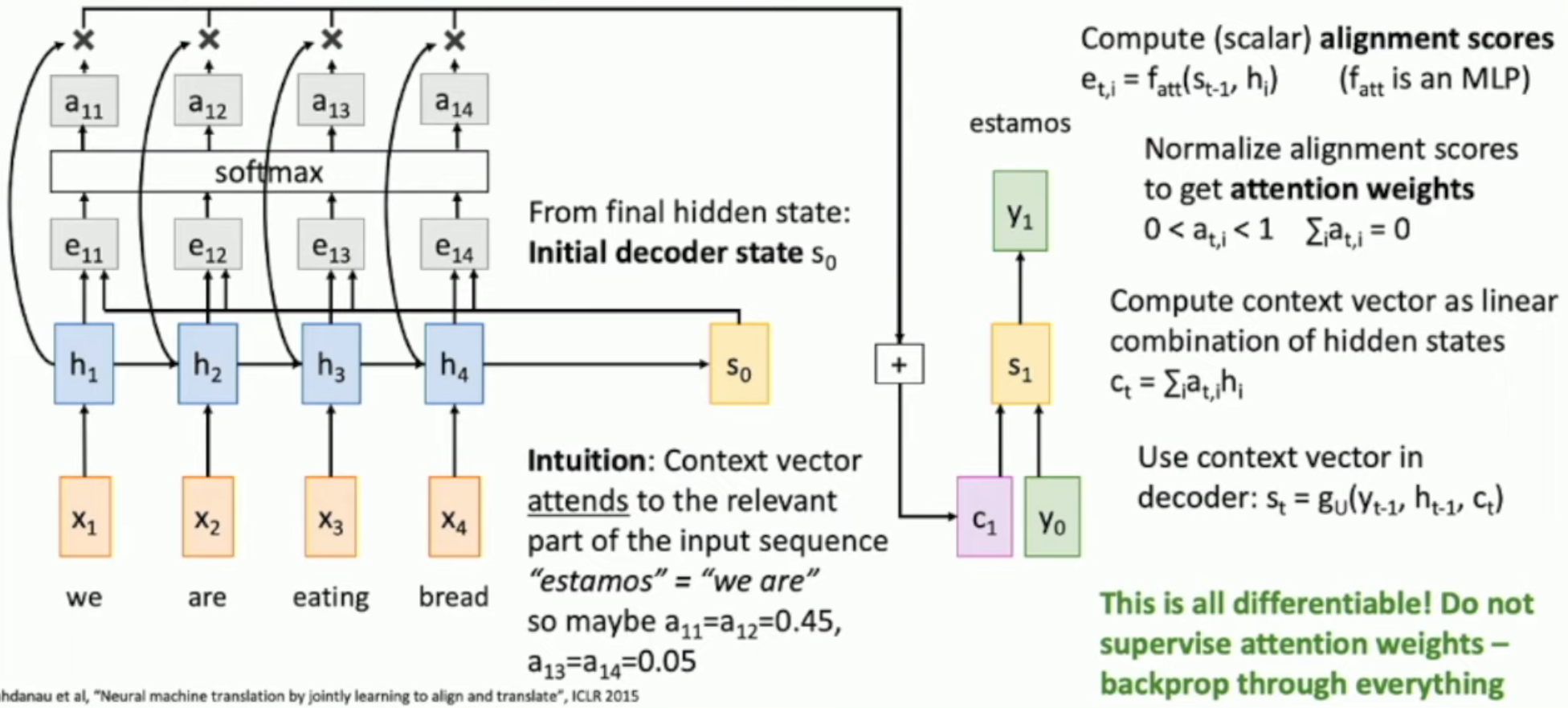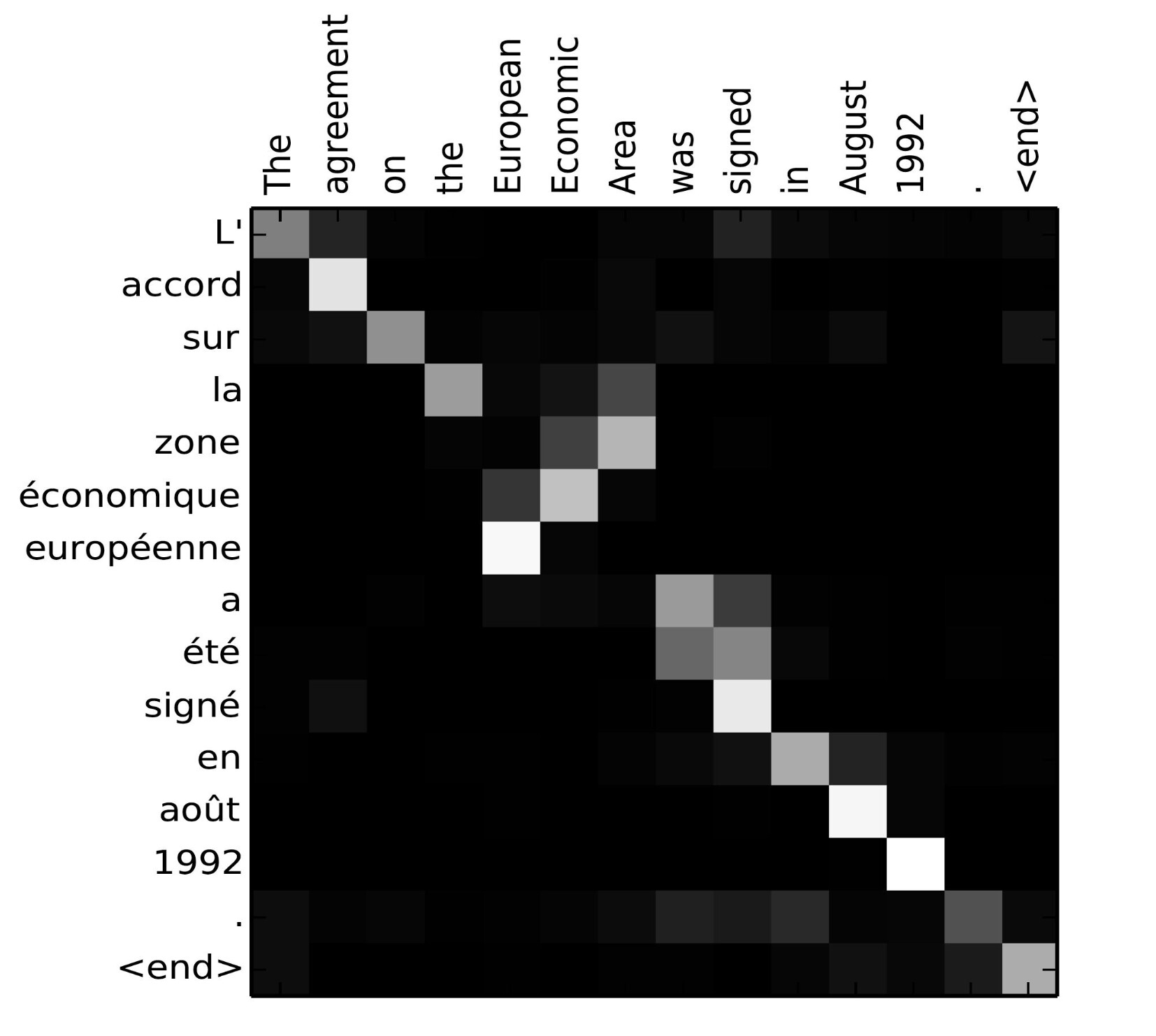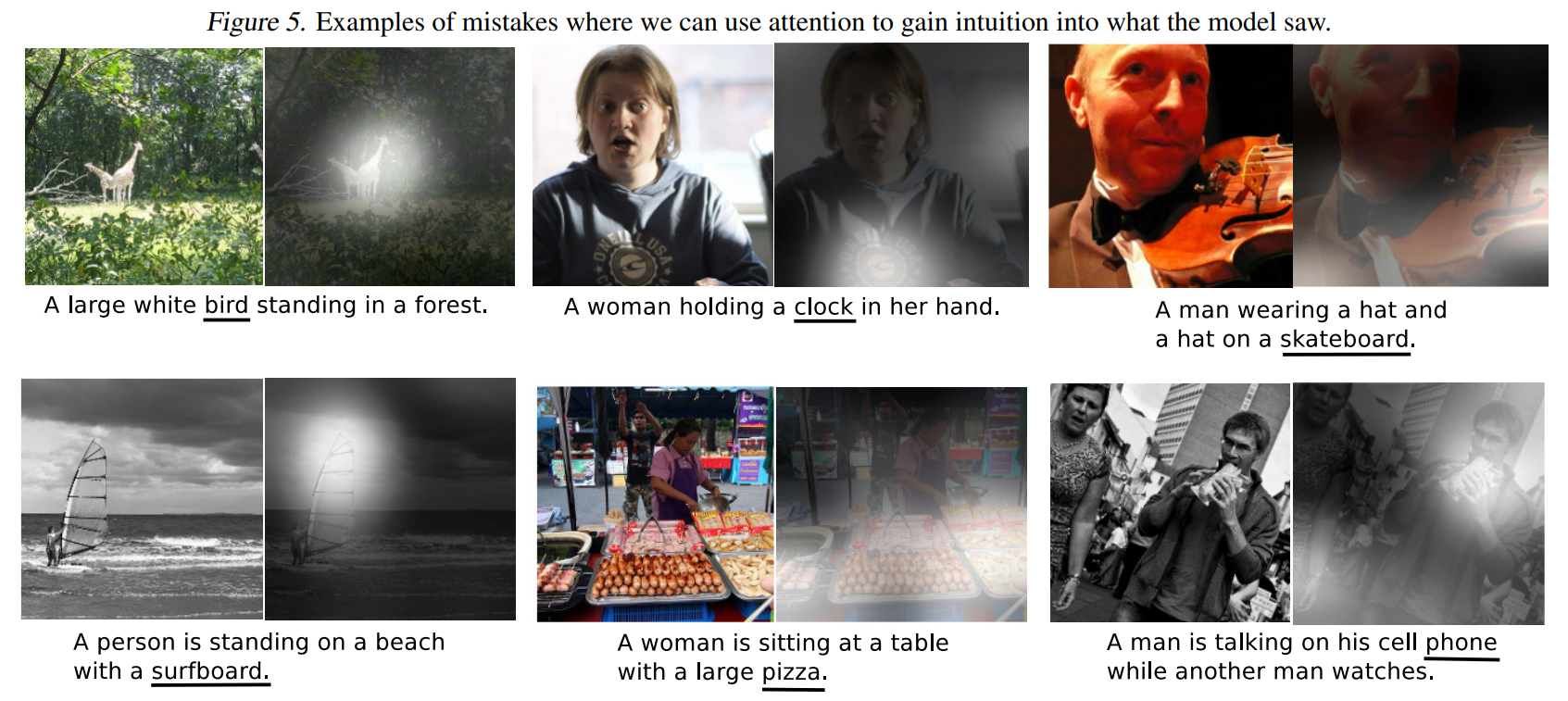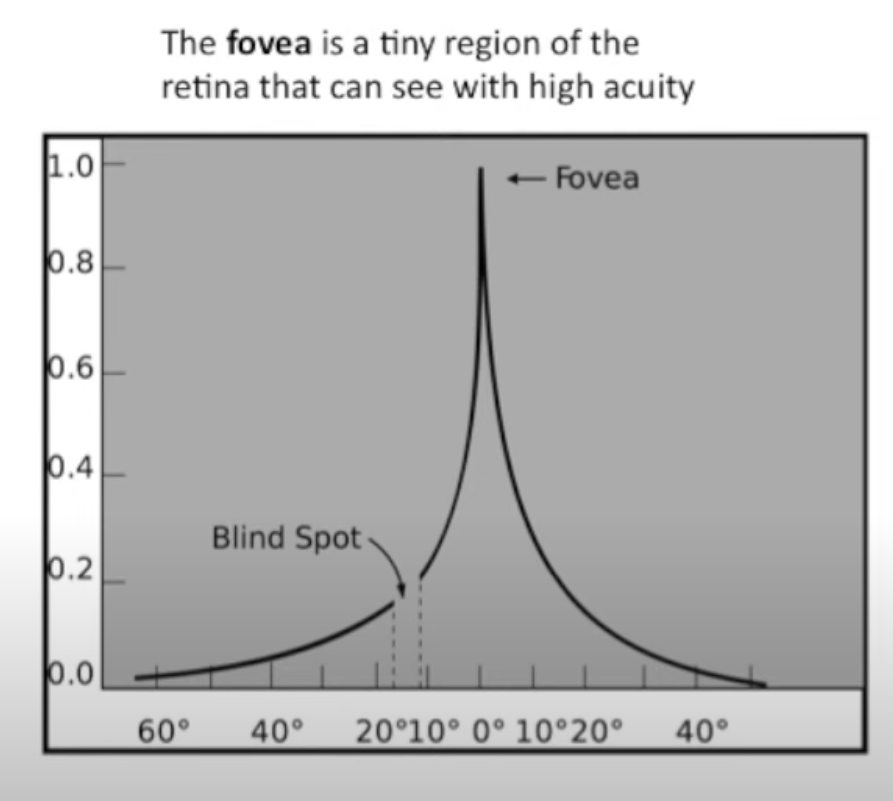Sequence-to-Sequence with RNNs

如图,对于 sequence to sequence(两者不一定对齐/等长)的文本转换,我们如果使用传统 RNN 架构,就如上图所示:
- 把所有关于原文的信息封装在 \(c\) 和 \(s_0\) 里面
可惜,\(c\) 的长度有限,直觉上+信息论上并不能够封装任意长的信息。因此,我们需要的是充分利用到每一个 \(h_i\)。
Attention Mechanism

如图,我们的 idea 是:
- 生成每一个词的时候,都让上一个状态来决定我们的对 \(h_1 \sim h_T\) 的 attention
- i.e. \(e_{t,i} = f_{att{(s_{t-1}, h_i)}}\),第 \(t\) 轮生成词语时,对第 \(i\) 个文本词语的 attention 就是 \(e_{t,i}\)
- 然后,我们通过该轮的 attention vector,加权平均得到 context vector,从而生成我们本轮的状态
比如:直觉上来说,"estamos" 在西语中,意思是 "we are",因此,对 "we" "are" 的 attention 应该差不多多,而对 "eating" "bread" 的 attention 也应该差不多少。
- 从而,我们既能够利用上所有的 \(h_i\)(i.e. 文本信息),也能够保证使用的合理性(i.e. 不是只取特定的 hidden state vector,而是根据需要来取用某一些 vectors。这和实际的语言翻译等工作是类似的)
Interpretability

如图,我们可以通过 attention 的矩阵,直接解读出哪些词语和哪些词语之间有关系——"European Economic Area" 和 "zone économique européenne" 是一一对应但是倒序的关系。
Observation: set not a sequence
这样的 naïve attention mechanism 并没有考虑到输入文本是一个 ordered sequence,而只是把输入文本当成了 unordered set。
- 作为对比,\(s_{t-1}\) 是一个 hidden state vector,intrinsically 考虑了临近性——i.e. 它大概只会“记录”附近的一些向量。但是通过 \(f_{att}\) 生成 \(e_{t,i}\) 的时候,却对于所有 \(h_i\) 一视同仁,而非更加注重某一些“更可能更有价值”的 \(h_i\)。
因此,attention mechanisn 可以使用于任何的 input,不论有没有序,比如图像等等。
Attention: Image2Caption
Recap: 我们之前的 image to caption via RNN 的方式,是将所有的 CNN 输出作为变量 \(\vec v\),输入到 RNN 中,

与之前的方法对比,我们之前是将整个 CNN 的输出作为变量 \(\vec v\)。而现在,我们是:
- 首先通过 CNN feature vector and previous state,生成 alignment scores
- 对 attention vector 进行 softmax 归一化,生成 attention weights
- 通过 attention weights 对 CNN feature vector 做加权平均,生成 \(c_n\)
- \(c_n\) 和 \(h_{i,j}\) 的形状是一样的。如果 \(h_{i,j}\) 是 vector,那么 \(c_n\) 也是;如果 \(h_{i,j}\) 是 scalar,那么同理
- 最后,才将 \(c_n\) (而不是 \(\vec v\))作为其中一个变量输入到函数中,生成 current state
Example

Biological Background

如图,只有视网膜黄斑附近的 visual acuity 最高,因此我们看东西的时候,会进行频繁的 saccade (眼跳动,也就是眼球转动),从而获得更多的信息。Attention 机制就是在模仿这种 saccade。
When To Use Attention?
If you want to
- convert one type of data into another type of data
- do it over time (i.e. one step at a time)
you can often use some kind of attention mechanism to cause the model to focus on different chunks/parts of input while generating each part of the output.
Generalized Attention Mechanism
First Generalization

相比我们之前使用的 attention mechanism
- 这里使用 scaled dot product 当作 \(f_{att}\)
- 为何需要 scale?因为 softmax 并不是 linear 的。\(20, 40\) 之间差了 \(e^{20}\),而 \(2, 4\) 之间只差了 \(e^2\)
- 另外,我们也避免使用神经网络这样复杂的结构来作为 \(f_{att}\),简化了运算
- 具体 scale 的原因,可以认为,这样能够让 \(\operatorname*{Var}(e_i - e_j)\) 在维数增加的时候,保持不变
- 最终结果是:\(ans = X^t \operatorname*{softmax}(Xq/\sqrt{D_Q})\)
- 其中,最后一行的 "(Shape: Dx)" 就是 DQ
Second Generalization
首先,上面一行只有 1 个 query。我们难道不能用多个 queries 吗?
也就是 $$ ans = X^t \operatorname*{softmax}(XQ/\sqrt{D_Q}, \dim=0) $$
- 其中,\(\dim=0\) 的意思就是:在行数变化的方向上,进行 softmax,也就是一列一列地 softmax。其中,每一列,就是我们一个 query 生成的 alignment scores
- e.g. 对于一个 9×9 的图片,
- 此处需要 reshape 为 27×3
- 然后,我们可以使用长度为 3 的 query,并且一次使用 9 个 queries,形成 3×9 的矩阵 \(Q\) ,
- 再和 \(X\) 相乘为 27×9 的 matrix of alignment scores(相乘之后要除以 \(\sqrt{D_Q} := \sqrt{3}\))
- 然后,再 softmax,形状不变,称为 matrix of weights
- 最后,与 \(X^t\) 相乘,就是 3×9 的 matrix of weighted picture
- 可以发现,matrix of queries 和 matrix of weighted pictures 的形状一样
Third Generalization



如上所示,相比 second generalization,我们增加了 K 和 V,而不是让 X 直接与 E、A 接触。
- i.e. 去掉上图中的 V 和 K,就是 second generalization;加上 V 和 K,就是 third generalization。
Variation: Self-Attention Layer


如上图所示,self-attention 不过不使用 query vector,而是把 input vector 经过 query matrix 当作 query vector。
不过,self-attention layer 有这样的性质:给定任意的 permutation matrix \(P\),都有 \(\operatorname*{self-attention}(PX) = P \cdot \operatorname*{self-attention}(X)\)。也就是说,self-attention layer 不考虑顺序。
- 从而,如果你希望让它考虑顺序,就要人为 encode 进去。
Variation: Masked Self-Attention Layer

如图,为了防止之前的预测使用之后的预测结果(关键是我们根本不知道),我们需要人为加上 mask。